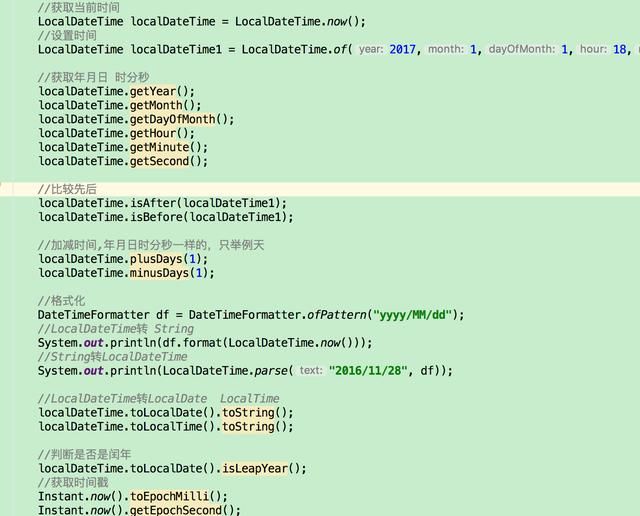Java8 时间操作
LocalDateTime
从Java 8开始,java.time包提供了新的日期和时间API,主要涉及的类型有:
- 本地日期和时间:
LocalDateTime,LocalDate,LocalTime; - 带时区的日期和时间:
ZonedDateTime; - 时刻:
Instant; - 时区:
ZoneId,ZoneOffset; - 时间间隔:
Duration。
以及一套新的用于取代SimpleDateFormat的格式化类型DateTimeFormatter。
注:LocalDateTime无法与时间戳进行转换,因为LocalDateTime没有时区,无法确定某一时刻。ZonedDateTime相当于LocalDateTime加时区的组合,它具有时区,可以与long表示的时间戳进行转换。
LocalDateTime:
最常用的LocalDateTime,它表示一个本地日期和时间:
public class Main {
public static void main(String[] args) {
LocalDate d = LocalDate.now(); // 当前日期
LocalTime t = LocalTime.now(); // 当前时间
LocalDateTime dt = LocalDateTime.now(); // 当前日期和时间
System.out.println(d); // 严格按照ISO 8601格式打印
System.out.println(t); // 严格按照ISO 8601格式打印
System.out.println(dt); // 严格按照ISO 8601格式打印
}
}
# LocalDateTime dt = LocalDateTime.now(); // 当前日期和时间
# LocalDate d = dt.toLocalDate(); // 转换到当前日期
# LocalTime t = dt.toLocalTime(); // 转换到当前时间
通过指定的日期和时间创建LocalDateTime
# 指定日期和时间:
LocalDate d2 = LocalDate.of(2019, 11, 30); // 2019-11-30, 注意11=11月
LocalTime t2 = LocalTime.of(15, 16, 17); // 15:16:17
LocalDateTime dt2 = LocalDateTime.of(2019, 11, 30, 15, 16, 17);
LocalDateTime dt3 = LocalDateTime.of(d2, t2);
# 因为严格按照ISO 8601的格式,因此,将字符串转换为LocalDateTime就可以传入标准格式:
LocalDateTime dt = LocalDateTime.parse("2019-11-19T15:16:17");
LocalDate d = LocalDate.parse("2019-11-19");
LocalTime t = LocalTime.parse("15:16:17");
DateTimeFormatter:
如果要自定义输出的格式,或者要把一个非ISO 8601格式的字符串解析成LocalDateTime,可以使用新的DateTimeFormatter:
public class Main {
public static void main(String[] args) {
// 自定义格式化:
DateTimeFormatter dtf = DateTimeFormatter.ofPattern("yyyy/MM/dd HH:mm:ss");
System.out.println(dtf.format(LocalDateTime.now()));
// 用自定义格式解析:
LocalDateTime dt2 = LocalDateTime.parse("2019/11/30 15:16:17", dtf);
System.out.println(dt2);
}
}
LocalDateTime
提供了对日期和时间进行加减的非常简单的链式调用:
public class Main {
public static void main(String[] args) {
LocalDateTime dt = LocalDateTime.of(2019, 10, 26, 20, 30, 59);
System.out.println(dt);
// 加5天减3小时:
LocalDateTime dt2 = dt.plusDays(5).minusHours(3);
System.out.println(dt2); // 2019-10-31T17:30:59
// 减1月:
LocalDateTime dt3 = dt2.minusMonths(1);
System.out.println(dt3); // 2019-09-30T17:30:59
}
}
月份加减会自动调整日期,例如从2019-10-31减去1个月得到的结果是2019-09-30,因为9月没有31日。
对日期和时间进行调整则使用withXxx()方法,例如:withHour(15)会把10:11:12变为15:11:12:
- 调整年:withYear()
- 调整月:withMonth()
- 调整日:withDayOfMonth()
- 调整时:withHour()
- 调整分:withMinute()
- 调整秒:withSecond()
public class Main {
public static void main(String[] args) {
LocalDateTime dt = LocalDateTime.of(2019, 10, 26, 20, 30, 59);
System.out.println(dt);
// 日期变为31日:
LocalDateTime dt2 = dt.withDayOfMonth(31);
System.out.println(dt2); // 2019-10-31T20:30:59
// 月份变为9:
LocalDateTime dt3 = dt2.withMonth(9);
System.out.println(dt3); // 2019-09-30T20:30:59
}
}
调整月份时,会相应地调整日期,即把2019-10-31的月份调整为9时,日期也自动变为30。
实际上,LocalDateTime还有一个通用的with()方法允许我们做更复杂的运算。例如:
public class Main {
public static void main(String[] args) {
// 本月第一天0:00时刻:
LocalDateTime firstDay = LocalDate.now().withDayOfMonth(1).atStartOfDay();
System.out.println(firstDay);
// 本月最后1天:
LocalDate lastDay = LocalDate.now().with(TemporalAdjusters.lastDayOfMonth());
System.out.println(lastDay);
// 下月第1天:
LocalDate nextMonthFirstDay = LocalDate.now().with(TemporalAdjusters.firstDayOfNextMonth());
System.out.println(nextMonthFirstDay);
// 本月第1个周一:
LocalDate firstWeekday = LocalDate.now().with(TemporalAdjusters.firstInMonth(DayOfWeek.MONDAY));
System.out.println(firstWeekday);
}
}
要判断两个LocalDateTime的先后,可以使用isBefore()、isAfter()方法,对于LocalDate和LocalTime类似
(4月在5月前返回true(isBefore), 4月在5月后返回false(isAfter))
public class Main {
public static void main(String[] args) {
LocalDateTime now = LocalDateTime.now();
LocalDateTime target = LocalDateTime.of(2019, 11, 19, 8, 15, 0);
System.out.println(now.isBefore(target));
System.out.println(LocalDate.now().isBefore(LocalDate.of(2019, 11, 19)));
System.out.println(LocalTime.now().isAfter(LocalTime.parse("08:15:00")));
}
}
Duration和Period
Duration表示两个时刻之间的时间间隔。另一个类似的Period表示两个日期之间的天数:
public class Main {
public static void main(String[] args) {
LocalDateTime start = LocalDateTime.of(2019, 11, 19, 8, 15, 0);
LocalDateTime end = LocalDateTime.of(2020, 1, 9, 19, 25, 30);
Duration d = Duration.between(start, end);
System.out.println(d); // PT1235H10M30S
Period p = LocalDate.of(2019, 11, 19).until(LocalDate.of(2020, 1, 9));
System.out.println(p); // P1M21D
}
}
注意到两个LocalDateTime之间的差值使用Duration表示,类似PT1235H10M30S,表示1235小时10分钟30秒。而两个LocalDate之间的差值用Period表示,类似P1M21D,表示1个月21天。
Duration和Period的表示方法也符合ISO 8601的格式,它以P...T...的形式表示,P...T之间表示日期间隔,T后面表示时间间隔。如果是PT...的格式表示仅有时间间隔。利用ofXxx()或者parse()方法也可以直接创建Duration:
Duration d1 = Duration.ofHours(10); // 10 hours
Duration d2 = Duration.parse("P1DT2H3M"); // 1 day, 2 hours, 3 minutes与传统的date互转
ZonedDateTime
LocalDateTime总是表示本地日期和时间,要表示一个带时区的日期和时间,我们就需要ZonedDateTime。
要创建一个ZonedDateTime对象,有以下几种方法,一种是通过now()方法返回当前时间:
public class Main {
public static void main(String[] args) {
ZonedDateTime zbj = ZonedDateTime.now(); // 默认时区
ZonedDateTime zny = ZonedDateTime.now(ZoneId.of("America/New_York")); // 用指定时区获取当前时间
ZoneId zoneId = ZoneId.of("Asia/Shanghai");
ZonedDateTime from = ZonedDateTime.from(LocalDateTime.now().atZone(zoneId));
// LocalDateTime转为ZonedDateTime(带时区的时间或日期)
LocalDateTime localDateTime = LocalDateTime.now(ZoneId.of("Asia/Shanghai")); // 上海时区
ZonedDateTime zonedDateTime = localDateTime.atZone(ZoneId.of("US/Pacific")); // 太平洋时区
// ZonedDateTime(带时区的时间或日期)转 LocalDateTime
LocalDateTime localDateTime1 = zonedDateTime.toLocalDateTime();
// 输出所有时区
Set set = ZoneId.getAvailableZoneIds();
set.forEach(System.out::println);
}
}
Instant
计算机存储的当前时间,本质上只是一个不断递增的整数。Java提供的System.currentTimeMillis()返回的就是以毫秒表示的当前时间戳。
这个当前时间戳在java.time中以Instant类型表示,我们用Instant.now()获取当前时间戳,效果和System.currentTimeMillis()类似:
public class Main {
public static void main(String[] args) {
Instant now = Instant.now();
System.out.println(now.getEpochSecond()); // 秒
System.out.println(now.toEpochMilli()); // 毫秒
// 以指定时间戳创建Instant:
Instant ins = Instant.ofEpochSecond(1568568760);
ZonedDateTime zdt = ins.atZone(ZoneId.systemDefault());
System.out.println(zdt); // 2019-09-16T01:32:40+08:00[Asia/Shanghai]
}
}
# LocalDateTime,ZoneId,Instant,ZonedDateTime和long都可以互相转换:
┌─────────────┐
│LocalDateTime│────┐
└─────────────┘ │ ┌─────────────┐
├───>│ZonedDateTime│
┌─────────────┐ │ └─────────────┘
│ ZoneId │────┘ ▲
└─────────────┘ ┌─────────┴─────────┐
│ │
▼ ▼
┌─────────────┐ ┌─────────────┐
│ Instant │<───>│ long │
└─────────────┘ └─────────────┘旧API转新API
如果要把旧式的Date或Calendar转换为新API对象,可以通过toInstant()方法转换为Instant对象,再继续转换为ZonedDateTime:
// Date -> Instant:
Instant ins1 = new Date().toInstant();
// Calendar -> Instant -> ZonedDateTime:
Calendar calendar = Calendar.getInstance();
Instant ins2 = Calendar.getInstance().toInstant();
ZonedDateTime zdt = ins2.atZone(calendar.getTimeZone().toZoneId());在使用Java程序操作数据库时,我们需要把数据库类型与Java类型映射起来。下表是数据库类型与Java新旧API的映射关系:
| 数据库 | 对应Java类(旧) | 对应Java类(新) |
|---|---|---|
| DATETIME | java.util.Date | LocalDateTime |
| DATE | java.sql.Date | LocalDate |
| TIME | java.sql.Time | LocalTime |
| TIMESTAMP | java.sql.Timestamp | LocalDateTime |
实际上,在数据库中,我们需要存储的最常用的是时刻(Instant),因为有了时刻信息,就可以根据用户自己选择的时区,显示出正确的本地时间。所以,最好的方法是直接用长整数long表示,在数据库中存储为BIGINT类型。

